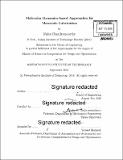Molecular dynamics-based approaches for mesoscale lubrication
Author(s)
Chandramoorthy, Nisha
DownloadFull printable version (10.18Mb)
Other Contributors
Massachusetts Institute of Technology. Computation for Design and Optimization Program.
Advisor
Nicolas G. Hadjiconstantinou.
Terms of use
Metadata
Show full item recordAbstract
Classical lubrication theory is unable to describe nanoscale flows due to the failure of two of its constitutive components: a) the Newtonian stress-strain rate relationship and b) the no-slip boundary condition. In this thesis, we present a methodology for deriving a modified Reynolds equation (referred to as the Molecular Dynamics-based Equation for Lubrication, or the MODEL) which overcomes these limitations by introducing a Molecular Dynamics-based constitutive relationship for the flow rate through the lubrication gap, that is valid beyond the range of validity of the Navier-Stokes constitutive models. We demonstrate the proposed methodology for the flow of a simple lubricant, n-hexadecane, between smooth Iron walls and show that the MODEL is able to predict flow rates with good accuracy even in nanochannels that are only a few atomic layers wide. The MODEL constitutive relationship for the flow rate used in this work is a slip-corrected Poiseuille model with the slip length and viscosity derived from Molecular Dynamics (MD) simulations of pressure-driven flow in nanochannels sufficiently large that the Navier-Stokes description is valid. Although more general expressions for the flow rate can certainly be used, for the lubricant-solid system modeled here, the slip-corrected Poiseuille flow was surprisingly found to be sufficient. We validate the MODEL by comparing MD results for the pressure distribution in a barrel-drop lubrication configuration with the analytical solution for the pressure obtained by solving the MODEL. The excellent agreement obtained between the dynamic pressure in the fluid measured from these MD simulations and the MODEL results suggests that it is possible to extend pde-based hydrodynamic modelling of lubrication problems even to nanoscale films beyond the validity of the Navier-Stokes description. In other words, once the flow rate constitutive relation is obtained, lubrication problems in nanoscale films can be solved without resorting to expensive particle methods like MD. We demonstrate that slip cannot be neglected in the boundary lubrication regime by considering various lubrication problems of practical interest. Using a simple barrel-drop lubrication model for the top two rings in an internal combustion engine, we show that for lubrication gaps with a minimum thickness that is ten times the size of the slip length, the normal force and the frictional force are overestimated by a factor of 1.5 when assuming no-slip. By modifying the Twin Land Oil Control Ring (TLOCR)-liner interface model to include slip, we find significant reduction in the hydrodynamic pressure and the friction when compared to the original model; the oil flow rate does not change appreciably. Finally, we chalk out a procedure for the inclusion of slip in the methodology for developing correlations for the pressure, friction and the flow rate in the TLOCR-liner system.
Description
Thesis: S.M., Massachusetts Institute of Technology, Computation for Design and Optimization Program, 2016. Cataloged from PDF version of thesis. Includes bibliographical references (pages 101-109).
Date issued
2016Department
Massachusetts Institute of Technology. Computation for Design and Optimization ProgramPublisher
Massachusetts Institute of Technology
Keywords
Computation for Design and Optimization Program.